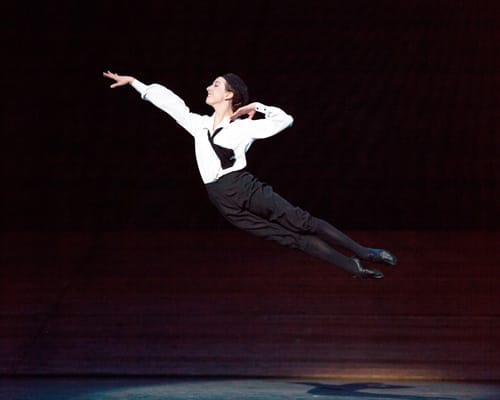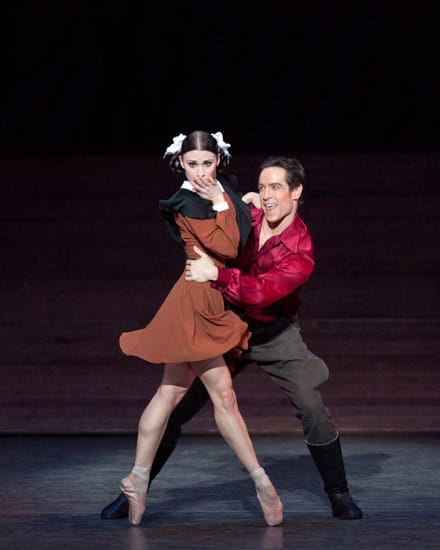Lessons Learned

"The Bright Stream"
American Ballet Theatre
Metropolitan Opera House
New York, NY
May 31, 2012
Alexei Ratmansky's "The Bright Stream", to Shastokovich's boisterous, danceable music, returned in all its delicious silliness. Yes, high-jinx on a Soviet collective farm might seem to be an odd basis for a good-hearted, loving comedy, but the stylized plot, with its disguises, its tricks, its straying husbands and forgiving wives, is one that Mozart would recognize. There is a formal underpinning to the seemingly topical ballet that gives it a human universality. Ratmansky has managed to blend classical structure (the first act is almost all pure divertissement, with beautifully formal corps dances merging into individual variations) with clear exposition (well, reasonably clear, though reading the plot summary is recommended) and brilliant character variations. The underlying message--people (especially men) are vain and foolish, but can laugh at themselves and learn from their mistakes, is timeless.
The put-upon wife was Julie Kent, who gave her opening solo reading that book (presumably something uplifting, like a biography of Sakhanov) a delicate and beautiful phrasing. In the second act, where she has to seduce her husband by pretending to be the visiting ballerina he has fallen for, she was able to shade her dancing to show both her enticing moves and that this was breaking her heart. She made it clear that there was anger behind her determination to win him back, as well as love. Pyotr, her straying husband, was the Russian phenom Ivan Vasiliev. His jumps were astounding and his landings secure, as he added some corkscrews in the air and ended his barrel turns with a flip over his leg, much to the audience's approval. For me though, there was a slight lack of generosity in his dancing; more "look at me" than "let me entertain you". I didn't feel that there was real contrition when he found out he was actually flirting with his wife, but he certainly left the audience delirious.

Isabel Boylston was the visiting ballerina who Pyotr fell for. She was witty, warm, and dynamic. There was a slight archness about her movements, as if she were conscious that she was a cut above these farmers, and she was very happy to flirt with whoever walked by. But there was genuine warmth in her dance with her friend Zina (friendship is rarely seen in choreography, and Ratmansky makes it seem so easy). The ballerina has a lot of dancing, and Boylston gave each piece its own feeling, from the playfullness and generosity in encouraging Zina to try the ballet steps they had learned as children, to the full-blooded jumps and firey point work as she joined in the folk dances.
Her partner, who spent most of the second act in a La Sylphide costume to trick the old dacha dweller (another man who wanted to stray from his wife), was the Danish-trained, Royal Ballet dancer Johan Kobborg. A man in a dress is guaranteed a laugh, but there are subtleties to the role, and each dancer I have seen approached it somewhat differently. Kobborg, with his large torso and shortish legs, took the Trocadero approach, defiantly male, with exaggerated female overtones. The sight of him gulping a drink, legs akimbo, and them daintily rearranging them with a "tee-hee-hee" was priceless.
The dacha dweller and his equally deluded wife were danced by Julio Bragado-Young and Nicola Curry. Unlike the other couples I have seen, they are both still young, and gave their parts a slight vaudeville tinge, exaggerating their moves. (They even did a couple of cartwheels during the finale, which for me was a joke too far.) Curry, especially, seemed to be trying to make the role funny, instead of bringing the character (with her all too human vanities) to life; the comedy is built into the role and doesn't need to be inserted.

The other supporting roles, though, as has been the case in every cast I have seen, were vivid, brilliantly characterized, and wonderfully danced. How Ratmansky loves his characters, from the garrulous inspector of quality (Alexei Agoudine), with his rollicking pride to the little school girl (Sarah Lane), with her frisky charm. Christine Shevchenko looked lovely in her red dress, and milked a mean cow. Sascha Radetsky was the Accordion Player, a man who apparently watched Rudolph Valentino in "The Four Horsemen of the Apocalypse" with the same devotion that Woody Allen gave to "Casablanca". He was utterly deflated when he realized he was being made fun of (his rival, the Tractor Driver, was dressed up as a dog and chased him away before jumping up and tangoing the heck out of the music), but was able to laugh at himself and join the fun. Radetsky gave this moment a light-hearted dignity that gently underlined the ultimate truth supporting this wonderful ballet--learn to laugh at yourself and people will forgive your faults.
copyright 2012 by Mary Cargill



